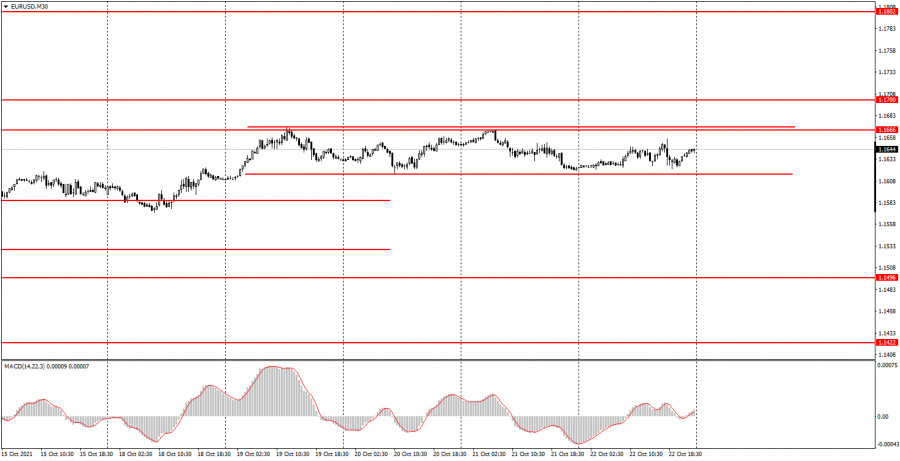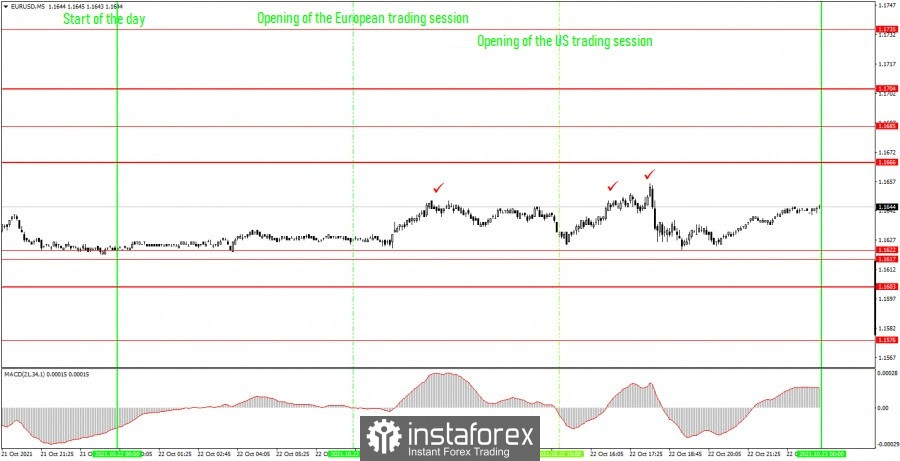Analysis of previous deals:
30M chart of the EUR/USD pair

The EUR/USD pair continued to trade very calmly on Friday. Unlike the pound/dollar pair, which has been trading in an upward trend for several weeks. However, the EUR/USD pair continues to move not just calmly, but inside the horizontal channel. At first, we did not want to plot the channel on the chart, hoping that after leaving one side channel, the pair would still start moving in a more trendy way. However, the harsh reality shows that the euro is still unwilling to trade actively. Traders continue to keep the pair in a sideways range with low volatility, which in most cases does not exceed 40 points. This was the case on Friday, when the pair went from a low to a high of 36 points, despite the fact that that day there were both macroeconomic reports and a speech by Federal Reserve Chairman Jerome Powell. However, does it make sense to talk about macroeconomic statistics if the markets do not pay any attention to it anyway? The first tick in the chart below marks the time when the data on business activity in the European Union was released. The second is data on business activity in the United States. As you can see, there was no market reaction. The price only fell by around 20 points during Powell's speech (third tick)...
5M chart of the EUR/USD pair

The technical picture is also very eloquent on the 5-minute timeframe. Sideways movement is clearly visible, and Friday's volatility was less than 40 points. Searching for trading signals in a horizontal channel is always very problematic, since they are usually false. Therefore, not only on Friday, but also in the last few days, there were practically none. The same applies to signals from the MACD indicator on the 30-minute timeframe, which there is simply no point in looking for now. Now you can only count on clear signals near the upper or lower borders of the side channel, 54 points wide. But even in this case, there is no guarantee that the pair will be able to move to the opposite border. Thus, no deals were opened on Friday, and perhaps this is for the best. Novice traders did not suffer losses in a blatant flat. Thus, the general trading strategy remains the same: looking for strong signals near the borders of the horizontal channel and waiting for a new upward or downward trend to form.
How to trade on Monday:
The pair is trading in a new flat on the 30-minute timeframe, and the volatility still does not exceed 40-50 points per day (in most cases). Thus, it is still very inconvenient to trade on the 30-minute TF, and we still do not recommend tracking signals from the MACD indicator. The key levels on the 5-minute timeframe for October 25 are 1.1603, 1.1617 - 1.1622, 1.1666 and 1.1685. Take Profit, as before, is set at a distance of 30-40 points. Stop Loss - to breakeven when the price passes in the right direction by 15 points. At the 5M TF, the target can be the nearest level if it is not too close or too far away. If it is located - then you should act according to the situation or work according to Take Profit. On Monday, the only more or less important report will be the US consumer confidence indicator. However, if the markets responded with a 20-point move to Powell's speech on Friday, then the likelihood of working out this report is close to zero. We need to wait for more important macroeconomic events. For example, the report on US GDP, which will be published on Wednesday.
Basic rules of the trading system:
1) The signal strength is calculated by the time it took to form the signal (bounce or overcome the level). The less time it took, the stronger the signal.
2) If two or more deals were opened near a certain level based on false signals (which did not trigger Take Profit or the nearest target level), then all subsequent signals from this level should be ignored.
3) In a flat, any pair can form a lot of false signals or not form them at all. But in any case, at the first signs of a flat, it is better to stop trading.
4) Trade deals are opened in the time period between the beginning of the European session and until the middle of the American one, when all deals must be closed manually.
5) On the 30-minute TF, using signals from the MACD indicator, you can trade only if there is good volatility and a trend, which is confirmed by a trend line or a trend channel.
6) If two levels are located too close to each other (from 5 to 15 points), then they should be considered as an area of support or resistance.
On the chart:
Support and Resistance Levels are the Levels that serve as targets when buying or selling the pair. You can place Take Profit near these levels.
Red lines are the channels or trend lines that display the current trend and show in which direction it is better to trade now.
The MACD indicator (14,22,3) consists of a histogram and a signal line. When they cross, this is a signal to enter the market. It is recommended to use this indicator in combination with trend lines (channels and trend lines).
Important speeches and reports (always contained in the news calendar) can greatly influence the movement of a currency pair. Therefore, during their exit, it is recommended to trade as carefully as possible or exit the market in order to avoid a sharp price reversal against the previous movement.
Beginners on Forex should remember that not every single trade has to be profitable. The development of a clear strategy and money management are the key to success in trading over a long period of time.
The material has been provided by InstaForex Company - www.instaforex.com